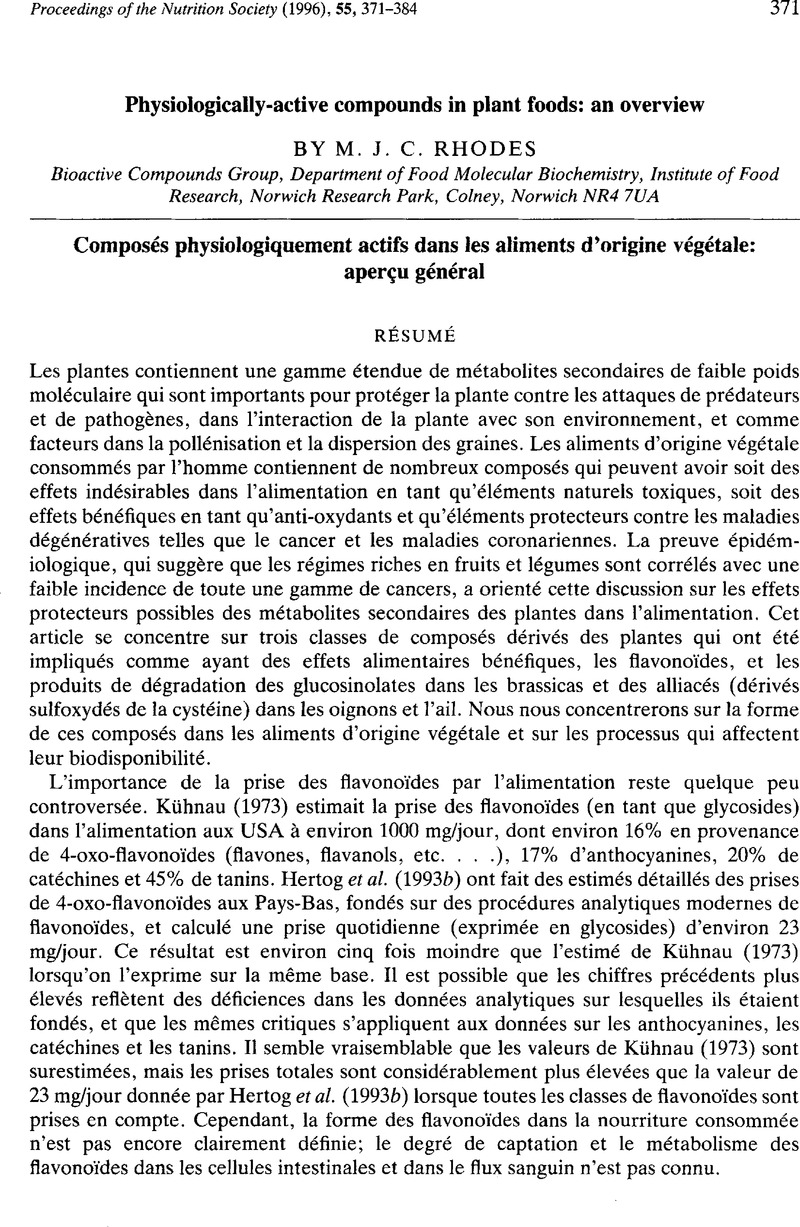Crossref Citations
This article has been cited by the following publications. This list is generated based on data provided by Crossref.
Eastwood, Martin
1997.
Principles of Human Nutrition.
p.
281.
Hasler, Clare M.
and
Blumberg, Jeffrey B.
1999.
Introduction.
The Journal of Nutrition,
Vol. 129,
Issue. 3,
p.
756S.
Jonkers, Daisy
Sluimer, Judith
and
Stobberingh, Ellen
1999.
Effect of Garlic on Vancomycin-Resistant Enterococci.
Antimicrobial Agents and Chemotherapy,
Vol. 43,
Issue. 12,
p.
3045.
Dulloo, AG
Seydoux, J
Girardier, L
Chantre, P
and
Vandermander, J
2000.
Green tea and thermogenesis: interactions between catechin-polyphenols, caffeine and sympathetic activity.
International Journal of Obesity,
Vol. 24,
Issue. 2,
p.
252.
Drewnowski, Adam
and
Gomez-Carneros, Carmen
2000.
Bitter taste, phytonutrients, and the consumer: a review.
The American Journal of Clinical Nutrition,
Vol. 72,
Issue. 6,
p.
1424.
Chantre, P.
and
Lairon, D.
2002.
Recent findings of green tea extract AR25 (Exolise) and its activity for the treatment of obesity.
Phytomedicine,
Vol. 9,
Issue. 1,
p.
3.
Meyer, A.S.
Suhr, K.I.
Nielsen, P.
and
Holm, F.
2002.
Minimal Processing Technologies in the Food Industries.
p.
124.
2003.
Plants: Diet and Health.
p.
302.
Huang, Ching-jang
2003.
Essential Fatty Acids and Eicosanoids.
Yazaki, Kazufumi
2004.
Handbook of Plant Biotechnology.
Farombi, E.O
Hansen, M
Ravn-Haren, G
Møller, P
and
Dragsted, L.O
2004.
Commonly consumed and naturally occurring dietary substances affect biomarkers of oxidative stress and DNA damage in healthy rats.
Food and Chemical Toxicology,
Vol. 42,
Issue. 8,
p.
1315.
Tolonen, M
Rajaniemi, S
Pihlava, J.-M
Johansson, T
Saris, P.E.J
and
Ryhänen, E.-L
2004.
Formation of nisin, plant-derived biomolecules and antimicrobial activity in starter culture fermentations of sauerkraut.
Food Microbiology,
Vol. 21,
Issue. 2,
p.
167.
2004.
Study on Antioxidant Potency of Green Tea by DPPH Method.
Journal of the Korean Society of Food Science and Nutrition,
Vol. 33,
Issue. 7,
p.
1079.
Jamroz, D.
Wiliczkiewicz, A.
Wertelecki, T.
Orda, J.
and
Skorupińska, J.
2005.
Use of active substances of plant origin in chicken diets based on maize and locally grown cereals.
British Poultry Science,
Vol. 46,
Issue. 4,
p.
485.
Kyle, Janet
and
Duthie, Garry
2005.
Flavonoids.
p.
219.
Belza, A
and
Jessen, A B
2005.
Bioactive food stimulants of sympathetic activity: effect on 24-h energy expenditure and fat oxidation.
European Journal of Clinical Nutrition,
Vol. 59,
Issue. 6,
p.
733.
Suzuki, Chise
Ohnishi-Kameyama, Mayumi
Sasaki, Keisuke
Murata, Takashi
and
Yoshida, Mitsuru
2006.
Behavior of Glucosinolates in Pickling Cruciferous Vegetables.
Journal of Agricultural and Food Chemistry,
Vol. 54,
Issue. 25,
p.
9430.
Böhm, V.
Kühnert, S.
Rohm, H.
and
Scholze, G.
2006.
Improving the Nutritional Quality of Microwave-vacuum Dried Strawberries: A Preliminary Study.
Food Science and Technology International,
Vol. 12,
Issue. 1,
p.
67.
Diniz, Yeda S.
Rocha, Katiucha K.H.R.
Souza, Gisele A.
Galhardi, Cristiano M.
Ebaid, Geovana M.X.
Rodrigues, Hosana G.
Novelli Filho, José Luiz V.B.
Cicogna, Antonio C.
and
Novelli, Ethel L.B.
2006.
Effects of N-acetylcysteine on sucrose-rich diet-induced hyperglycaemia, dyslipidemia and oxidative stress in rats.
European Journal of Pharmacology,
Vol. 543,
Issue. 1-3,
p.
151.
Jamroz, D.
Wertelecki, T.
Houszka, M.
and
Kamel, C.
2006.
Influence of diet type on the inclusion of plant origin active substances on morphological and histochemical characteristics of the stomach and jejunum walls in chicken.
Journal of Animal Physiology and Animal Nutrition,
Vol. 90,
Issue. 5-6,
p.
255.



